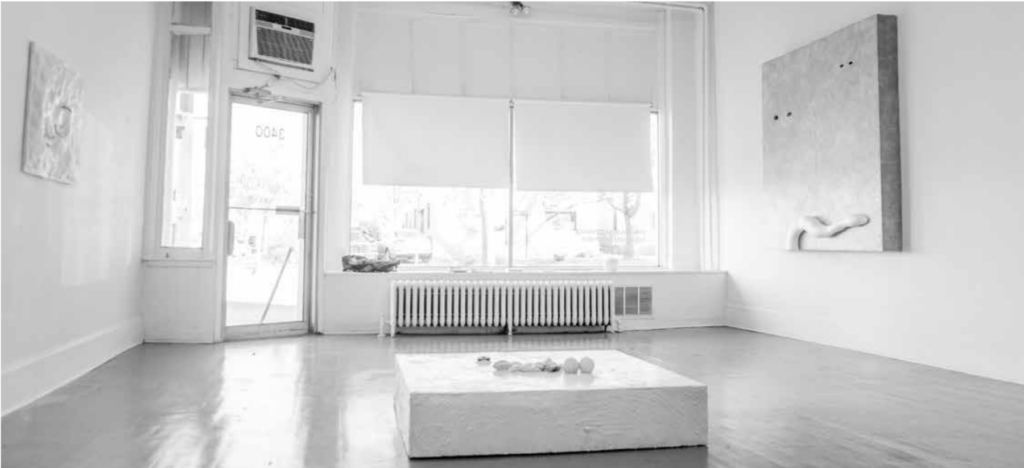Virginia Rose Torrence: Not What I Remember
Review I by Sheila Dickinson
The White Page
Oct 14–Nov 14, 2016

Reminiscent of many things that do not go together, but suddenly, now, do. Reminiscent of organic, amorphous, body-like forms found in early feminist art. Indicative of explorations of identity, subjectivity and sexuality in her world. Reminiscent of abstraction, but representational objects surface. Still none of these concepts are the topic. In this resides the success of the work, the poetry of what is not there, a presence that resonates throughout the show. Do I need to tell you what it is? Can you not see it? Languishing in every piece, the female body feels enigmatic but charged. Not in the same cheeky way as Tracy Emin, who put her empty bed on display, Torrence’s Untitled (She) displays only a cloth and a piece of fruit on a large rectangular pedestal, the female body feeling recently departed. Her body is made more palpable by the artistic process of slathering plaster and wax over large boxy shapes of cream and rose colored foam. The result is gloopy uneven surfaces that cover everything in their wake, including the fake fruit and other objects that lie muted underneath. The waxy sheen makes it all look a little wet and just finished, leaving a constant freshness intact. Without ever seeing her, she is everywhere.
There is much that is not enunciated, left open for the viewer to complete, like poetry—a key influence on the artist. Torrence talks about her month in residence at The White Page as a time of taking on new materials, leaving behind her training in ceramics, and reading a lot of poetry. Her materials are inventive, unconventional–bases for floor and wall pieces made from large, boxy foam, once squishy, now hardened with plaster, paint and wax covering them–or–made out of hydrocal, a malleable wet plaster, lighter than clay, but producing a similar result. The hydrocal works all hang on the wall, as if to pronounce its own place as art, but the forms are strange, guttural utterances that fall outside recognition. Working in a new medium may make these unclear formations necessary, but there seems to be a willed seclusion from external influences. In the utopian studio setting, white, frothy with experimentation, the artist emerges stronger, brimming with potential.
Despite this, I’ve lost interest. By the time my gaze lands upon the large pink square relief hanging on the wall, Untitled (Portrait and Snake), which holds two sets of eyes cut into the foam box shape and a white snake-like form at the bottom of the large composition, I am bored of the experiment. This is not due to a lack of skill and effort on the part of the artist. It is the boredom I feel when I encounter art that languishes mostly in abstraction without concept, idea, or something beyond poetry sustaining my interest. I want to believe that this studio based sculpture is encouraging experimentation beyond the self, that there is integrity in the tactile work of this woman artist.1 What I wonder is why this type of art making is still necessary, thus relevant to a young woman artist trained in ceramics? Why make art that reeks of gloopy organic substances (the tactile) that still avoids representation of the female body?
In one respect, this poetic, if not precious work is refreshing when seen in contrast to more didactic defiant self-portraits by young women that subscribe to the resistance narrative. I appreciate Torrence’s subtlety, but I wonder how effectual her poetic sculptural tactic is today or if she is taking part in an artistic conversation that was interesting and important decades ago. What does it mean that in 2016, a young woman sculptor is retracing such similar aesthetic territory? It might signify that the project of feminism is not over in art. Linda Benglis, Eva Hesse, Marisa Merz, all went into similar terrain in the 1960’s and 70’s as a way to find another means to convey an aesthetic not pronounced before them.
Forty years later, how do we make sense of derivative work? Is this what we can expect from artists who are not conversant with feminist art history or theory and work in the isolated context of the studio, intent on creating from purely internal motivations? It feels like without being given the contextual tools of the informed artist, young artists are at a disadvantage and are forced to reinvent the wheel. Torrence revisiting these early feminist forms tells me that not enough feminist art history is being taught in art schools, causing young women artists to continue to need to discover these aesthetic forms themselves. As a result we will need to keep bearing witness to these discoveries.
